by Ian Sebire
It is one of the great paradoxes of maritime history that the supremacy of jet aircraft in the late 1950s ushered in a final era of ‘Ships of State’ on the North Atlantic.
Just like their predecessors in the 1930s, these vessels were designed to provide a physical manifestation of the nation, showcasing engineering and artistic talent. Furthermore, in contrast to today’s cruise fleet, crews were drawn almost exclusively from the homeland, a seagoing microcosm of the countries they represented.
In this atmosphere of one-upmanship ZIM Lines, principal shipping company of the fledgling state of Israel, ordered a new national flagship.
ZIM Lines had been incorporated in 1945, in what was then British Administered Palestine. The company’s first passenger ship was the 2,499grt SS Kedmah. Although diminutive in size this was a symbolically significant vessel and when she arrived in her homeland on 28th July 1947 a national holiday was declared. On 14th May1948 the State of Israel was formed and so Kedmah and her successors were involved in shuttling settlers and tourists between Marseilles, Genoa, Naples and Haifa.
This intra-Mediterranean service extended to New York on 4th April 1954 when Israel’s first transatlantic liner, Jerusalem, cast off from Haifa, calling at Limassol, Malta, Cannes and Halifax en route. Jerusalem was originally Norwegian America Line’s Bergensfjord of 1913. Having served the Norwegians for over 33 years and survived two World Wars she had inaugurated Home Lines service to South America in 1947, before being purchased by ZIM.
In 1955 and 1956 the company added a pair of elegant 9,855grt passenger-cargo vessels, which were named Israel and Zion. Renowned for their stylish, modern interiors, they were built at the Deutsche Werft shipyard at Hamburg and funded by German reparation payments. Primarily for intra-Mediterranean service, ZIM added two near sisters in 1957 and 1958. Named Jerusalem (the original liner having been re-named Alrya in 1957) and Theodore Herzl, their shallower 21ft draft was the main difference from the earlier twins and they therefore only occasionally made transatlantic crossings.
The German built quartet were a source of great pride for both company and country but the directors formulated even more ambitious plans. They conceived a transatlantic liner more than twice the size of Israel and Zion, which could double as an off-season cruise ship.
To build their new flagship ZIM commissioned the famed Chantiers de L’Atlantique yard at Saint Nazaire. The order was placed in 1959 as the French Line’s France was taking shape on the slipway. France would be the last ship to be launched in the conventional manner as contemporary shipbuilding methods forsook the inclined ramp. All subsequent new builds would be constructed in a level graving dock, including the, as yet unnamed, ZIM liner.
French designers and architects worked in conjunction with Israeli colleagues, notably Al Mansfield and Ben Kaplan, under the overall supervision of Project Manager Captain Rimon and technical superintendent, and Israeli Defence Force naval officer, Edmond Brillant. The new ship’s profile combined a characteristically svelte Penhoet bow with a lofty superstructure featuring a tiered, curved, forward bulkhead. The stern decks descended to a gracefully sculpted spoon stern that appeared deceptively low. The general arrangement of twin, athwart ship funnels, set about two thirds aft, drew obvious comparisons with Holland America’s Rotterdam and P&O’s Canberra.
Like Rotterdam and the new France, two classes were catered for, First and Tourist. Cabin accommodation was delineated horizontally with First class in the superstructure and Tourist class predominantly in the hull. In contrast the public rooms were primarily split vertically, fore (First class) and aft (Tourist class). Shared facilities like the theatre, nightclub and shopping arcade were located amidships. Dedicated stairwells served each class, with four in total located along the central axis, supplemented by five adjoining lifts. In view of the ship’s transatlantic schedule enclosed promenades were provided for each class but her itinerary on the ‘Sunny southern’ route meant separate swimming pools and adjacent lido areas were also incorporated into the design.
Passenger accommodation and facilities were spread over ten decks. At the top, Bridge Deck was as the name suggests, where the bridge, chart room and adjacent officer accommodation was located. The only passenger access was to a centrally located regulation size tennis court. The eponymous Lido Deck below incorporated the sheltered First class swimming pool and outdoor promenades on each flank.
Descending from Lido Deck was the first full width superstructure deck, called the Olive Branch promenade. The forward section consisted of 29 outside First class cabins, including 4 large suites with views over the bow. Amidships was the 290 seat theatre/cinema and adjacent barber and beauty parlour. Like the large children’s rooms aft, these served both classes. Aft on the port side was the Tourist class winter garden. The majority of the flanks on this deck were given over to the First class enclosed promenade, although there was a small section of Tourist class enclosed promenade on the starboard side and some outside deck space, facing aft. The main lounges for both classes were located on Rainbow deck. Furthest forward was the First class Circle Lounge, with views over the bow. Although actually oval in shape, the name was derived from the plethora of circular features incorporated within it. There were circular clusters of Egg and Swan chairs located on green circles, inlaid on the blue carpeting, surrounding circular tables. Light pillars and the tiled dance floor were similarly all spherical, which inevitably formed the theme of Jacob Wechster’s vibrant tapestries adorning the walls. Moving aft on the starboard side were the First class library and Peace Pipes smoking room, then a smaller ‘interchangeable’ library, used primarily by tourist passengers.
To port were a series of classless rooms, first and largest was the Noah’s Ark night club, a popular late night venue, with a depiction of animals ‘two by two’ by artist Victor Browner. Shopping outlets flanked the broad central corridor which led into the largest Tourist class lounge, located amidships, called the Hava Nagilah Hall. This spanned the full width of the ship. A further large vestibule led to the main Tourist class stairwell, with lifts on either side and doors to the second large Tourist class bar/lounge, called The Tavern. Like the Hava Nagilah Hall this included a large circular dance floor. Flanked by enclosed promenades The Tavern’s aft end opened onto the Tourist class lido and swimming pool.
Dove deck included the First class entrance hall with access to first class cabins forward, interchangeable in the centre and Tourist class aft. Like elsewhere on the ship, almost all this accommodation was outside and provided en-suite bathrooms. Central on Dove deck was the richly decorated Synagogue, whilst a small interdenominational chapel was provided for Christian passengers.
Both Tourist and First class (forward) dining rooms were located on Dining deck served by a central kosher kitchen. There were also some Tourist cabins aft. With the exception of the well equipped hospital Main Deck was comprised entirely of Tourist cabins with small pockets also on A and B deck, although these decks were primarily crew accommodation and mess areas etc. Descending into the bowels of the ship the lowest passenger space was the indoor swimming pool. Centrally placed on Ophir deck, this minimised the potential for disruption from rolling or pitching.
At 629 feet long and with a beam of 82 feet the 25,320 gross ton vessel would be more than double the tonnage of her predecessors. Passenger capacity was initially just 72 in First Class and 1,018 in Tourist class with a crew of 469. There was considerable interest and deliberation over the name of the new flagship. Initially strong biblical references were favoured, with King Solomon, his Hebrew name Shlomo-Hametech and King David leading contenders. Ultimately, after the almost complete ship had been floated out of the building dock on 10th November 1962, she was named Shalom by Mrs Paula Ben Gurion, wife of the Israeli Prime Minister. The choice of name was inspired. Meaning peace in Hebrew, Shalom was perceived as a more international and perhaps optimistic choice for an embattled nation that was perpetually in conflict with its Arab neighbours.
On 24th January 1964, Shalom departed Saint Nazaire for trials off Belle Ile. Her two CEM Parsons geared turbines achieved 22.7 knots, proving admirably up to the task of maintaining her contracted 20 knot service speed. In February ZIM took delivery and she steamed on a dual purpose delivery voyage/shakedown cruise, receiving a tumultuous arrival at Haifa on 3rd March 1964. A further series of brief ‘shakedown’ cruises commenced on 20th March, fully testing systems and crew prior to the maiden transatlantic crossing, which departed on 17th April.
The fortunate first passengers enjoyed a ship of startling modernity. Having stepped aboard they encountered the futuristic angular stairwells, with open treads illuminated by vibrant murals. The avant-garde interior décor, co-ordinated by Dora Gad continued throughout the vessel, including a topographical plaster relief with contrasting tapestry in the First Class Carmel restaurant and vivid enamels and backlit stained-glass panels of its Tourist equivalent. Contrasts were everywhere, from the black and white body of the theatre with its bold orange and yellow seating, to the greens and blues of the aforementioned Circle lounge. Each cabin had the same basic fixtures and fittings but were individualised by the contrasting colour schemes of upholstery and soft furnishings.
When she arrived in New York on a dank, spring day, after a 14 day crossing that included calls at Naples, Marseille and Malaga, Shalom was afforded the customary tug and fireboat reception to her Manhattan pier. ZIM were justifiably proud of their new flagship. Initial reports suggested that much of the £7.5 million construction cost was funded by reparations payments but this was vehemently denied by the company.
Bookings were initially strong, however by 1964 transatlantic traffic was already in terminal decline. As passenger numbers diminished, competition amongst the lines increased. Whilst Shalom was certainly the largest and fastest vessel sailing from Israel, she faced stiff competition from the incumbent Italian, Greek and American Export Lines on the Mediterranean service generally. It was immediately apparent that more first class passenger accommodation was required and so a very early refurbishment was scheduled for the end of the first transatlantic season. In October she steamed to the Wilton-Fijenoord shipyard at Schiedam in Holland where 76 first class berths were added, eleven cabins being created out of the former Noah’s Ark nightclub, resulting in a revised capacity of 148 first and 864 tourist passengers.
Shalom had been designed from the start for single class off-season cruising with a reduced capacity of just 650, serviced by an increased crew complement of 500. Sailing directly from her Dutch refit, she was provisioned at New York for a series of Caribbean cruises.

Fully booked, Shalom cast off from her Manhattan pier for the first cruise on 26th November 1964. Despite thick fog and frigid temperatures there was an atmosphere of excited anticipation on board. Then, just hours out of New York, 28 miles south west of Ambrose lightship, tragedy struck. In scenes horribly reminiscent of the Andrea Doria sinking 8 years previously, the speeding Shalom’s fine bow loomed out of the fog and sliced through the middle of the Norwegian tanker Stolt Dagali. The stern portion of the tanker quickly sank, killing 19 crew members. With her bow crushed, Shalom limped back to New York, off-loading her passengers on a far from festive thanksgiving morning, before sailing to the local Todd shipyards in Brooklyn for repairs.
ZIM Lines passenger division and Shalom in particular, never really recovered. In fact, whilst no individual factor can be blamed, there were many ingredients which conspired to limit her popularity and profitability. Perhaps most obviously she had no running mate, resulting in a disjointed and protracted timetable. She encountered strong competition from the established Mediterranean shipping lines and increasingly from the well-funded and expansive state airline El Al. Israeli crew members were amongst the most highly paid of all nationalities. Furthermore, whilst both the designers and owners had tried to promote her international appeal, Shalom was regarded as a resolutely Jewish ship, a view only reinforced by the Chief Rabbinate’s insistence that only Kosher food should be served on transatlantic service. This dissuaded non-Jews and the many, particularly American, non-practicing Jews, from choosing the ZIM liner.
By 1967 the position had become untenable. Broader political developments, including the Egyptian blockade of southern Israeli ports and the build-up of Arab forces along her borders, led to the pre-emptive six day war of 5th to 10th June 1967. Although militarily and strategically successful, for ZIM lines these tensions only exacerbated the difficulty of attracting a proportion of the rapidly dwindling sea-going clientele. Of greatest concern it also alienated the ship from prospective cruise goers. So after just three years of service ZIM looked for a buyer and as is so often the case, circumstances provided an immediate answer.
In the late 1950s an enterprising Dane, Axel Bitsch-Christensen (known affectionately as ABC) had established Hamburg Atlantic Line, using the rebuilt Canadian Pacific Liner Empress of Scotland. Renamed Hanseatic there developed a loving bond with the people of her home port of Hamburg, that retains its intensity to this day. Hanseatic was a highly successful ship, sailing profitably on cruises and crossings in the early 1960s when most competitors were foundering in a sea of red or wholly reliant on state subsidies.
On 7th September 1966, this prosperity came to an abrupt end when an engine room fire, whilst berthed at New York, rendered Bitsch-Christensen’s pride and joy beyond economic repair. By this time planning was already advanced towards a successor. To finance the project ABC had formed a new company Deutsche Atlantik Line (German Atlantic Line) in 1965 and commissioned three major German shipyards to prepare preliminary designs. A month after Hanseatic’s demise the new vessel was ordered but this left a void of almost three years until completion.
Shalom was an ideal replacement. Not only was she virtually new but her dimensions almost precisely mirrored those of the company’s new build. Negotiations started in May 1967 but deep-seated wartime political sensitivity intervened again. Unsurprisingly, there were members of the ZIM board who felt it was inappropriate for an Israeli flagship to be sold to a German shipping line. Meanwhile Shalom undertook a series of 10-14 day cruises to Montreal in connection with Expo 67.
There were also financial concerns. Although the insurance payout from the burnt out Hanseatic was supplemented by a share issue, ultimately it required a 38 million mark loan from ZIM lines to secure the Shalom. She was handed over on 9th November 1967 to sail under the German Atlantic Line banner, although retaining the funnel livery (red with a black top and white Hanseatic cross) of the former Hamburg-Atlantic Line. The new acquisition was re-christened Hanseatic to trade off the previous, beloved ship’s fine reputation. As if to emphasise the association, the name was painted in huge black lettering on each side of the bow. Otherwise Shalom’s all white livery was retained.
Initially little material change was required although the decks and public rooms were renamed to reflect the new owners. Olive Branch promenade simple became Promenade Deck with Rainbow, Dove and Dining decks becoming Salon, Upper and Restaurant respectively. Lounges were renamed the Hamburg Salon, Alster Club and Atlantic Club whilst new passengers would eat in the Helgoland and Bellevue restaurants.
On 16th December 1967 Hanseatic sailed from Hamburg on an inaugural private cruise to the Canary Islands before repositioning to Port Everglades for the end of January 1968. After six more cruises she left Florida on 22nd April 1968, called at New York on the 25th then steamed to Southampton, Le Havre and Cuxhaven. There were five further transatlantic roundtrips in 1968 but these would be the last scheduled liner voyages of her career. Subsequently they would only occur as positioning voyages between her European summer cruise programme and winters in the Caribbean or around South America. Typically, she would sail from Cuxhaven to the Norwegian Fjords and Baltic, offer Mediterranean cruises out of Genoa and then an extended winter programme from Port Everglades.
In March 1969 Hanseatic was joined by the new Hamburg. They were a popular pairing. There was a brief, joint arrangement with North German Lloyd which broke down largely because the latter’s aging Bremen, and Europa were simply more costly to run than the modern Hamburg and Hanseatic. Nevertheless, German Atlantic was already financially ailing. The principal operating costs, fuel and manpower, spiralled in the early 1970s whilst the devaluation of the dollar reduced already diminishing profits. Meanwhile, as companies pulled out of scheduled liner services, competition in the cruise sector increased.
Unable to finance ongoing operations and repayments on the acquisition of Hanseatic and Hamburg, German Atlantic decided to sell the former. Circumstance again found a ready buyer. Home Lines whose chairman Eugen Eugenides had been instrumental in helping ‘ABC’ establish Hamburg Atlantic Line sought a replacement for the venerable Homeric, again a victim of fire. Hanseatic was purchased.
When she entered Home Line service as Doric in January 1974, the most obvious alteration was at the stern. What had originally been called Dove and Rainbow decks were extended aft, creating an expansive lido around the former tourist class swimming pool. The now redundant cargo handling equipment and kingposts, were also removed. Although only ten years old, the interiors were thoroughly refurbished to fit the expectations of her new clientele. Doric took over Homeric’s annual cruise programme, from April to October she would sail from New York each Saturday on a seven day return trip to Bermuda. At the adjacent berth fleet mate Oceanic would depart for Nassau on the same weekly cycle, as the Manhattan finger piers became a focus of the Big Apple Italian community. In October Doric would decamp to Port Everglades, repeating many of her Hanseatic itineraries to the West Indies and occasional longer cruises to South America. Like all Home Lines vessels she earned high praise for her cuisine and the warm service provided by her Italian crew. Carrying a reduced complement of 945 one class (first class) passengers, Doric’s success prompted the company to order a replacement.
In February 1982, as the new ship Atlantic was nearing completion at La Seyne, Home Lines received a substantial offer for Doric from the Greek operator Royal Cruise Lines. The new owners sent her to Perama for a major refurbishment, updating and upgrading her interiors in line with their existing smaller Golden Odyssey, whilst also revitalising her machinery. Renamed Royal Odyssey the most significant visual change was the replacement of her twin funnels by a single conical structure, broadly similar to Royal Viking Line’s trio and loosely based on the QE2’s. Sporting a crown motif on the white casing flanks of her funnel, a blue stripe on her hull and her name in gold lettering, Royal Odyssey presented a handsome, balance profile. Arguably the most significant change was however below the waterline, where the installation of a new bulbous bow improved fuel efficiency, speed but also dramatically improved her sea keeping qualities.
Other structural changes included removing the original first class swimming pool on lido deck, whilst the other pool was moved further aft, placing it centrally on the extended deck space created by Home Lines. A new lounge was built on its original location. Internal modifications included the extension of the aft lounge originally known as The Tavern into the now redundant enclosed promenade and several new passenger cabins in place of former officers accommodation, the Winter Garden and the children’s playrooms. The refit replaced the cosy, if rather mundane, Doric décor and furnishings with a contemporary 1980s feel. Royal Cruise Line had established an excellent reputation since its inception eight years earlier with Golden Odyssey. Royal Odyssey would now expand their formula of first class service and facilities, to worldwide itineraries.
On 27th May 1982, the new company flagship was handed over to her proud owners. She departed Piraeus on a maiden cruise terminating at Tilbury on 11th June, just three days before British victory in the Falklands conflict. After early mechanical gremlins had been ironed out, Royal Odyssey settled into a seasonal pattern of cruises, summers split between Scandinavia and the Mediterranean, winters in the Caribbean, along America’s West coast and across the Pacific. Generally she was a trouble-free popular vessel, once again garlanding profits and prestige for her satisfied owners.
Nevertheless in an eerie repeat of the incident twenty years earlier, Royal Odyssey rammed and severely damaged the Vasya Alekseev, a Soviet freighter, whilst steaming between Sweden and Denmark in July 1984. Fortunately, on this occasion there was no loss of life and both vessels were repaired at Danish shipyards.
To maintain their strong reputation in the prestige cruise market, Royal Cruise Line decided to order a new ship in the late 1980s. Royal Odyssey was again put on the sales list and once again found a ready buyer, in fellow Greek-based Regency Cruises. Like Royal Cruise Line, the new owners were a relatively new operator with Royal Odyssey supplementing two other former liners, Regent Sea (the former Swedish America Line’s Gripsholm) and Regent Star (originally Holland America’s Statendam). With only superficial modifications and livery changes she was soon into her fifth career as Regency Sun, sailing to the Caribbean, Canada’s east coast and Alaska over the next seven years. The early and mid 1990s were a time of increasing competition and consolidation in the cruise industry. With the big players, Carnival and RCI, absorbing established lines and investing in new tonnage it became increasingly difficult for smaller operators, especially those with older vessels that were more costly to maintain. Rumours of financial difficulties were confirmed when Regency Cruise Line was declared bankrupt in October 1995. Regency Sun was arrested at Nassau.
As she was now into her fourth decade there seemed little prospect of further employment, especially as maintenance had been compromised in later years, as Regency economised. She remained laid up, steadily deteriorating until November 1999. To great surprise she was sold at auction to the Canon Regency Spa Group who planned to rebuild her as a 300 passenger luxury cruise ship. They stripped her interiors but then re-appraised the planned $40 million investment. Initial publicity was quietly dropped and Regency Sun remained tethered and abandoned.
Inevitably, when she did ultimately depart her berth in May 2001, as Sun, it was for the scrap yards of Alang. Unable to make way under her own steam, she was taken in tow by the ocean-going tug Hua An, on a south easterly course to the Cape of Good Hope.
Conditions worsened in the depths of the southern hemisphere’s winter and as the vessels skirted South Africa the towline parted. Sun wallowed impotently until rescued by a local salvage tug and subsequently the line to Hua An was reconnected. She was however already listing heavily on the evening of 26th July when the crew of the Chinese tug severed the tow, allowing the former flagship of the Israeli merchant marine, a vessel that had given faithful service to five separate owners, to slip beneath the waves forever.

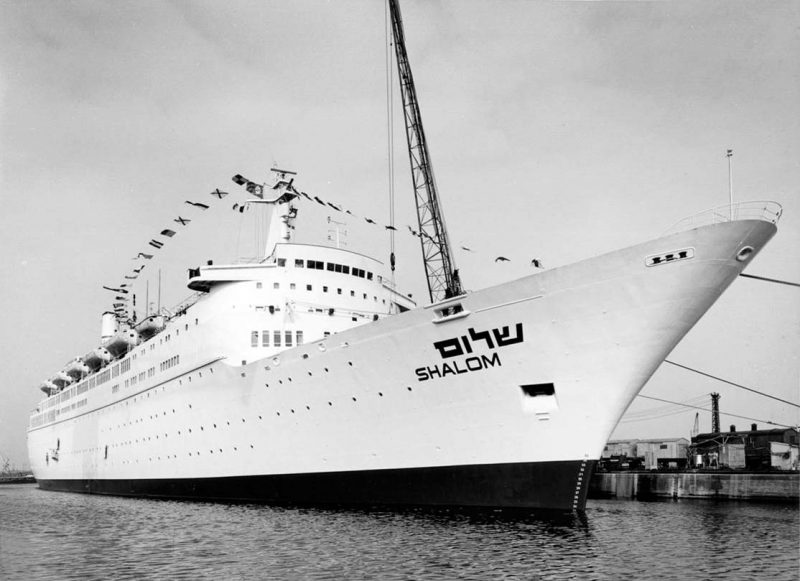

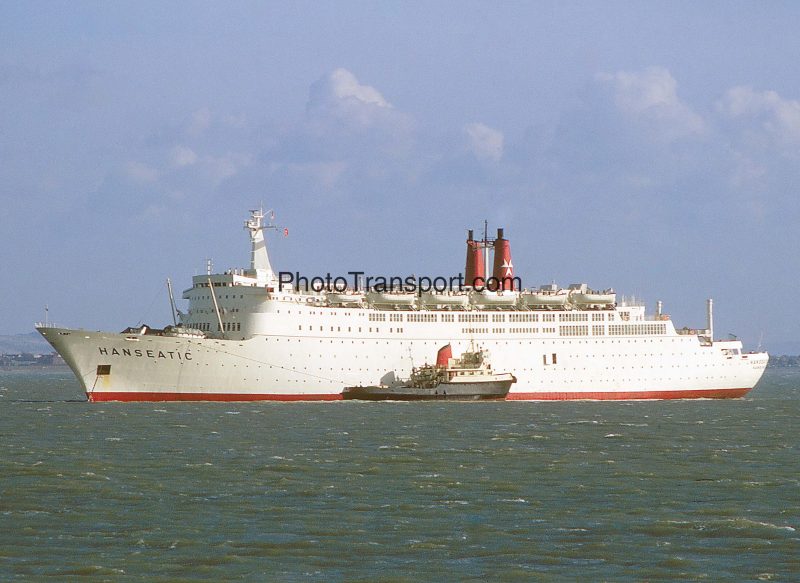
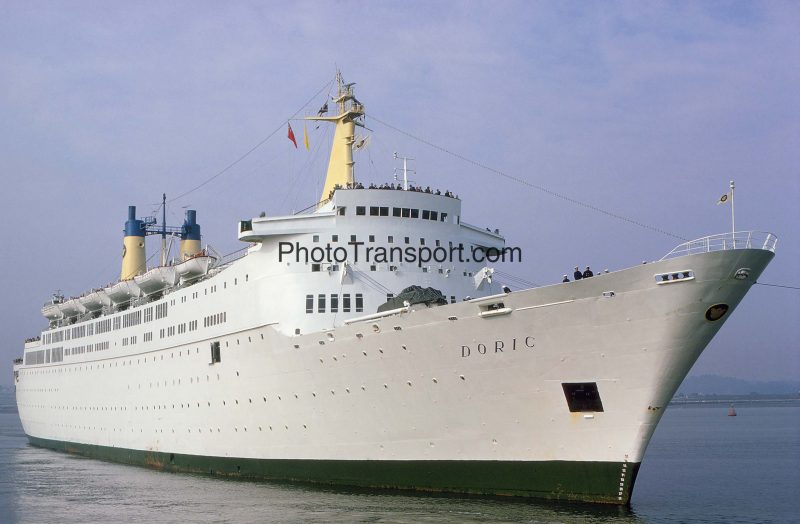

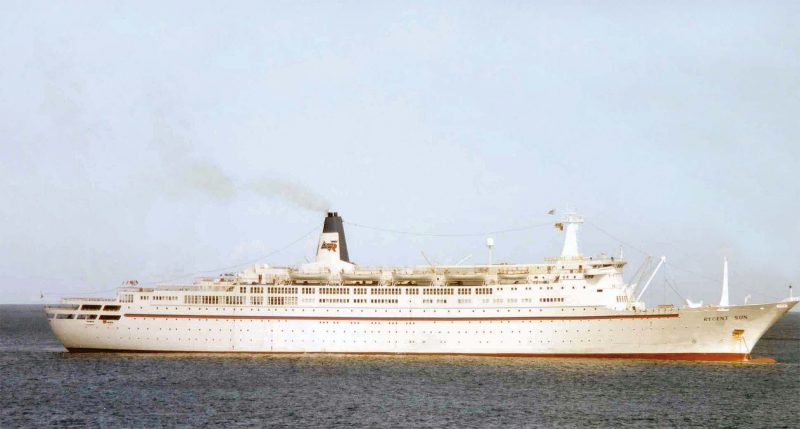
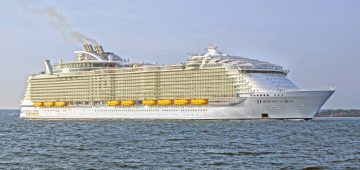



Comments
Sorry, comments are closed for this item